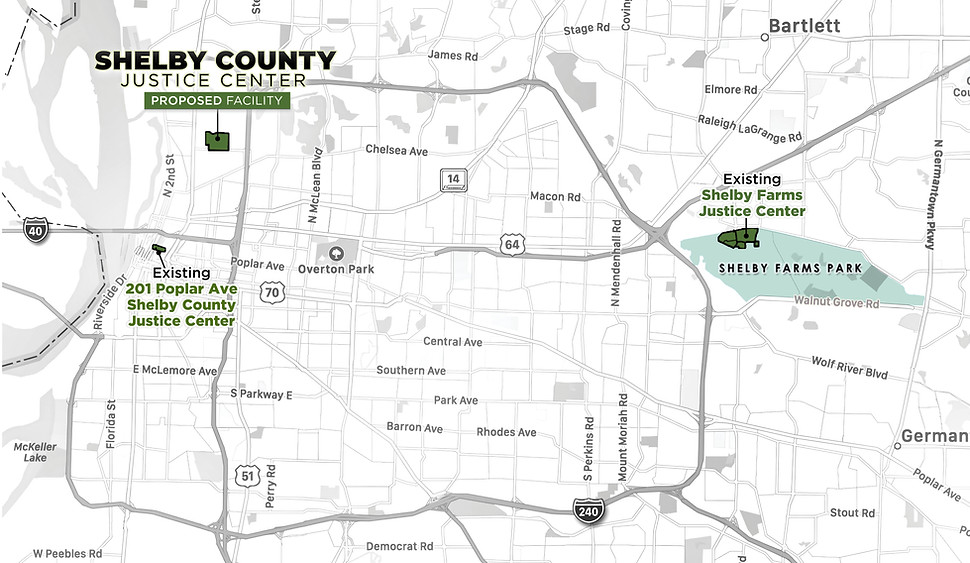The Challenge
Dated, Unsafe, & Divided Infrastructure
For decades, the justice system in Memphis has operated across a patchwork of buildings—some over a century old, others outdated and inefficient. From the aging 201 Poplar complex (1981) to the long-antiquated Shelby Farms penal farm, these scattered sites no longer meet the demands of our community – nor the people they are designed to serve.
Below are key reasons why moving to a new, centralized justice complex, starting with 201 Poplar, is not just smart—it’s necessary:
-
Aging buildings are costly, inefficient, and unsafe for employees and detainees
-
Transportation between facilities is risky and costly
-
Consolidation improves workflow, security, and accessibility
-
Old layouts don’t support modern justice needs or rehabilitation
-
Environmental and operational sustainability
-
Long-term economic and civic investment with a new approach
Memphis’s justice system is long overdue for a unified, modern facility that replaces the fragmented, outdated infrastructure currently in use. Consolidating operations into a new location is not just about convenience—it’s about safety, efficiency, fiscal responsibility, and creating a system that works better for everyone involved.
It’s time to invest in a justice center that reflects the future, not the past.

The Opportunity
Goals for the Future
Safety, Security & Efficiency
With all justice services in one location, safety, security, efficiency, and quality of life are enhanced. Old, inefficient, and expensive-to-maintain structures will be replaced with new, state-of-the-art facilities. These money-saving, secure, and attractive buildings will ensure justice system operations work faster and more smoothly. Keeping everything on one secure site improves the safety of both detainees and the public and optimizes efficiency. Natural light and open areas for detainees, as well as better access and improved parking for visitors and employees, would be included.
With state-of-the-art facilities, recidivism can be reduced, leading to a safe community.
Local Economy Impact
New jobs and businesses in New Chicago will help grow the local economy. Thousands of jobs means more dollars invested in this area will open the door for future growth and improvements.
Downtown Memphis
Existing buildings in downtown Memphis will be freed up for new uses and continued opportunities for revitalization
THE VISION
Future Phases

THREE-FOLD OPPORTUNITY
Reactivate 71 acres in North Memphis
-
Reactivate a property and neighborhood in need of investment – Site has been vacant since the 1980s
-
Opportunity for community redevelopment – Retail and services to serve the needs of Justice Center employees, the visiting public, and the New Chicago neighborhood
-
+/-71 Acres at Firestone Ave and Morehead St
-
Large site allows for a low-rise project and ample surface parking
-
Future expansion potential for other Justice Center components
-
Immediate access to I-40 and Downtown Memphis – Six minutes from downtown Memphis
-
Located in an Opportunity Zone with New Markets Tax Credits available, plus additional tax credits for solar, reducing the cost for the County and taxpayers
-
Zoned I-H (Industrial – Heavy)
-
Public-Private Partnership – Experienced developer with deep government experience ready to build and leaseback with future options to purchase, creating maximum optionality for the County.
-
3 miles & 6 minutes from the current detention facility at 201 Poplar
Transform downtown Memphis & Shelby Farms
-
Frees up +/- 8.1 acres at the current location downtown for higher-use redevelopment and increased tax revenue
-
Provides for the relocation of the detention facility at Shelby Farms, allowing the land to be redeveloped
Other Sites Considered
-
The CTAS report commissioned by the County suggested two other options 1) downtown and 2) Area 10 at Shelby Farms
-
Downtown would be hugely expensive due to having to go vertical, and there is no place to temporarily house detainees
-
Shelby Farms is not zoned for this use; much of the land is in a floodplain, the road infrastructure is inadequate, and no utility infrastructure exists. Neither sites have the incentives that Firestone has. As such, both would require a much larger investment and would be unaffordable

Building a Better Future
Relocation Plan

Justice Center Team
Contact



